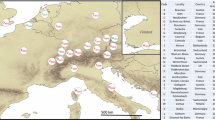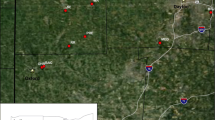Abstract
Identifying routes of invasions of exotic organisms is an essential step to prevent further introductions and to manage established populations. The invasion of North America by the lily leaf beetle (Lilioceris lilii) is well documented, but the source(s) of the introduced population(s) and the geographical pathway(s) followed by the beetle during its progression in North America remain unknown. We used amplified fragment length polymorphism to characterize the genotype of 516 individuals across 25 locations in North America and 9 locations in Europe. Genetic clustering analyses and principal coordinate analyses revealed clear genetic differences between individuals from Canada and the USA, suggesting two different episodes of introduction in North America, a first one in Montréal, QC, Canada, in 1943 and a second one in Cambridge, Massachusetts, United States of America, in 1992. Population allocation analyses further suggested that the invasive populations of L. lilii originated from northern Europe, probably in southern United Kingdom and the western part of Germany. Finally, dates of first mentions of the beetle across North America, paired with the genetic diversity of the beetles at each location, showed that there are two separate routes of invasion of L. lilii with distinctive patterns of dispersal.





Similar content being viewed by others
References
Alda F, Ruiz-López MJ, García FJ, Gompper ME, Eggert LS, García JT (2013) Genetic evidence for multiple introduction events of raccoons (Procyon lotor) in Spain. Biol Invasions 15:687–698
Audisio P (2011) Fauna Europaea: Lilioceris lilii. In: Fauna Europaea version 2.4. http://www.faunaeur.org/full_results.php?id=243537. Accessed 11 May 2012
Benestan L, Gosselin T, Perrier C, Sainte-Marie B, Rochette R, Bernatchez L (2015) RAD-genotyping reveals fine-scale genetic structuring and provides powerful population assignment in a widely distributed marine species; the American lobster (Homarus americanus). Mol Ecol 24:3299–3315
Berti N, Rapilly M (1976) Liste d’espèces et révision du genre Lilioceris Reitter (Col. Chrysomelidae). In: Faune d’Iran. Annales de la Société Entomologique de France (Nouvelle série), France, pp 31–73
Boissin E, Hurley B, Wingfield M, Vasaitis R, Stenlid J, Davis C, Groot PD, Ahumada R, Carnegie A, Goldarazena A (2012) Retracing the routes of introduction of invasive species: the case of the Sirex noctilio woodwasp. Mol Ecol 21:5728–5744
Bonin A, Bellemain E, Bronken Eidesen P, Pompanon F, Brochmann C, Taberlet P (2004) How to track and assess genotyping errors in population genetics studies. Mol Ecol 13:3261–3273
Bouchard AM, McNeil JN, Brodeur J (2008) Invasion of American native lily populations by an alien beetle. Biol Invasions 10:1365–1372
Buschman J (2004) Globalisation-flower–flower bulbs–bulb flowers. IX Int Symp Flower Bulbs 673:27–33
Ciosi M, Miller N, Kim K, Giordano R, Estoup A, Guillemaud T (2008) Invasion of Europe by the western corn rootworm, Diabrotica virgifera virgifera: multiple transatlantic introductions with various reductions of genetic diversity. Mol Ecol 17:3614–3627
Colbeck GJ, Turgeon J, Sirois P, Dodson JJ (2011) Historical introgression and the role of selective vs. neutral processes in structuring nuclear genetic variation (AFLP) in a circumpolar marine fish, the capelin (Mallotus villosus). Mol Ecol 20:1976–1987
Darling JA, Bagley MJ, Roman J, Tepolt CK, Geller JB (2008) Genetic patterns across multiple introductions of the globally invasive crab genus Carcinus. Mol Ecol 17:4992–5007
Day R (1993) Lilioceris lilii. A report to E.O. Stockbridge, OIC. APHIS, 10 Causeway St., Boston, MA, USA
Dlugosch K, Parker I (2008) Founding events in species invasions: genetic variation, adaptive evolution, and the role of multiple introductions. Mol Ecol 17:431–449
Donovan GH, Butry DT, Michael YL, Prestemon JP, Liebhold AM, Gatziolis D, Mao MY (2013) The relationship between trees and human health: evidence from the spread of the emerald ash borer. Am J Prev Med 44:139–145
Duchesne P, Bernatchez L (2002) AFLPOP: a computer program for simulated and real population allocation, based on AFLP data. Mol Ecol Notes 2:380–383
Earl DA (2012) STRUCTURE HARVESTER: a website and program for visualizing STRUCTURE output and implementing the Evanno method. Conserv Genet Resour 4:359–361
Estoup A, Guillemaud T (2010) Reconstructing routes of invasion using genetic data: why, how and so what? Mol Ecol 19:4113–4130
Evanno G, Regnaut S, Goudet J (2005) Detecting the number of clusters of individuals using the software STRUCTURE: a simulation study. Mol Ecol 14:2611–2620
Excoffier L, Laval G, Schneider S (2005) Arlequin (version 3.0): an integrated software package for population genetics data analysis. Evol Bioinform Online 1:47
Falush D, Stephens M, Pritchard JK (2007) Inference of population structure using multilocus genotype data: dominant markers and null alleles. Mol Ecol Notes 7:574–578
Guillemaud T, Beaumont MA, Ciosi M, Cornuet J-M, Estoup A (2010) Inferring introduction routes of invasive species using approximate Bayesian computation on microsatellite data. Heredity 104:88–99
Hufbauer RA, Roderick GK (2005) Microevolution in biological control: mechanisms, patterns, and processes. Biol Control 35:227–239
Jakobsson M, Rosenberg NA (2007) CLUMPP: a cluster matching and permutation program for dealing with label switching and multimodality in analysis of population structure. Bioinformatics 23:1801–1806
Jensen JL, Bohonak AJ, Kelley ST (2005) Isolation by distance, web service. BMC Genetics 6: 13. v.3.23 http://ibdws.sdsu.edu
Jombart T, Devillard S, Balloux F (2010) Discriminant analysis of principal components: a new method for the analysis of genetically structured populations. BMC Genet 11:94
Kalinowski ST (2011) The computer program STRUCTURE does not reliably identify the main genetic clusters within species: simulations and implications for human population structure. Heredity 106:625–632
Kang M, Buckley YM, Lowe AJ (2007) Testing the role of genetic factors across multiple independent invasions of the shrub Scotch broom (Cytisus scoparius). Mol Ecol 16:4662–4673
Kolbe JJ, Glor RE, Schettino LR, Lara AC, Larson A, Losos JB (2004) Genetic variation increases during biological invasion by a Cuban lizard. Nature 431:177–181
Labeyrie V (1963) Lilioceris. In: Balachowsky AS (ed) In Entomologie Appliquée à l’Agriculture, Tome 1. Masson and Cie, Paris, pp 588–595
LeSage L (1983) Note sur la distribution présente et future du criocère du lys, Lilioceris lilii Scopoli (Coleoptera: Chrysomelidae), dans l’est du Canada. Le Nat Can 110:95–97
LeSage L, Elliott B (2003) Major range extension of the lily leaf beetle (Coleoptera: Chrysomelidae), a pest of wild and cultivated Liliaceae. Can Entomol 135:587–588
Liebhold AM, Tobin PC (2008) Population ecology of insect invasions and their management. Annu Rev Entomol 53:387–408
Lombaert E, Guillemaud T, Lundgren J, Koch R, Facon B, Grez A, Loomans A, Malausa T, Nedved O, Rhule E (2014) Complementarity of statistical treatments to reconstruct worldwide routes of invasion: the case of the Asian ladybird Harmonia axyridis. Mol Ecol 23:5979–5997
Mack RN, Simberloff D, Lonsdale MW, Evans H, Clout M, Bazzaz FA (2000) Biotic invasions: causes, epidemiology, global consequences, and control. Ecol Appl 10:689–710
Majka CG, Kirby C (2011) Lily leaf beetle, Lilioceris lilii (Coleoptera: Chrysomelidae), in Maine and the Maritime Provinces: the continuing dispersal of an invasive species. J Acad Entomol Soc 7:70–74
Majka CG, LeSage L (2008) Introduced leaf beetles of the maritime provinces, 5: The lily leaf beetle, Lilioceris Lilii (Scopoli) (Coleoptera: Chrysomelidae). Proc Entomol Soc Wash 110:186–195
Marrs R, Sforza R, Hufbauer R (2008) Evidence for multiple introductions of Centaurea stoebe micranthos (spotted knapweed, Asteraceae) to North America. Mol Ecol 17:4197–4208
McFadden MW, McManus ME (1991) An insect out of control? The potential for spread and establishment of the gypsy moth in new forest areas in the United States. In: Baranchikov YN, Mattson WJ, Hain FP, Payne TL (eds) Forest insect guilds: patterns of interaction with host trees. U.S. Forest Service General Technical Report NE-153
Orlóci L (1978) Multivariate analysis in vegetation research. Junk, The Hague
Orlova-Bienkowskaja MJ (2013) Dynamics of the range of lily leaf beetle (Lilioceris lilii, Chrysomelidae, Coleoptera) indicates its invasion from Asia to Europe in the 16th–17th century. Rus J Biol Invasions 4:93–104
Pascual M, Chapuis M, Mestres F, Balanya J, Huey R, Gilchrist G, Serra L, Estoup A (2007) Introduction history of Drosophila subobscura in the New World: a microsatellite-based survey using ABC methods. Mol Ecol 16:3069–3083
Peakall R, Smouse PE (2006) GenAlEx 6: genetic analysis in Excel. Population genetic software for teaching and research. Mol Ecol Notes 6:288–295
Peakall R, Smouse PE (2012) GenAlEx 6.5: genetic analysis in Excel. Population genetic software for teaching and research—an update. Bioinformatics 28:2537–2539
Pejchar L, Mooney HA (2009) Invasive species, ecosystem services and human well-being. Trends Ecol Evol 24:497–504
Pelletier TA, Carstens BC (2014) Model choice for phylogeographic inference using a large set of models. Mol Ecol 23:3028–3043
Pimentel D, McNair S, Janecka J, Wightman J, Simmonds C, O’connell C, Wong E, Russel L, Zern J, Aquino T (2001) Economic and environmental threats of alien plant, animal, and microbe invasions. Agric Ecosyst Environ 84:1–20
Pritchard JK, Stephens M, Donnelly P (2000) Inference of population structure using multilocus genotype data. Genetics 155:945–959
R Development Core Team (2013) R: a language and environment for statistical computing. R Foundation for Statistical Computing, Vienna, Austria. http://www.R-project.org/
Rice WR (1989) Analyzing tables of statistical tests. Evolution 43:223–225
Rollins LA, Woolnough AP, Wilton AN, Sinclair R, Sherwin WB (2009) Invasive species can’t cover their tracks: using microsatellites to assist management of starling (Sturnus vulgaris) populations in Western Australia. Mol Ecol 18:1560–1573
Rosenberg NA (2004) DISTRUCT: a program for the graphical display of population structure. Mol Ecol Notes 4:137–138
Rosenthal DM, Ramakrishnan AP, Cruzan MB (2008) Evidence for multiple sources of invasion and intraspecific hybridization in Brachypodium sylvaticum (Hudson) Beauv. in North America. Mol Ecol 17:4657–4669
Shirk R, Hamrick J, Zhang C, Qiang S (2014) Patterns of genetic diversity reveal multiple introductions and recurrent founder effects during range expansion in invasive populations of Geranium carolinianum (Geraniaceae). Heredity 112:497–507
Suarez AV, Holway DA, Case TJ (2001) Patterns of spread in biological invasions dominated by long-distance jump dispersal: insights from Argentine ants. Proc Natl Acad Sci USA 98:1095–1100
Tatem AJ, Hay SI, Rogers DJ (2006) Global traffic and disease vector dispersal. Proc Natl Acad Sci USA 103:6242–6247
Tepolt C, Darling J, Bagley M, Geller J, Blum M, Grosholz E (2009) European green crabs (Carcinus maenas) in the northeastern Pacific: genetic evidence for high population connectivity and current-mediated expansion from a single introduced source population. Divers Distrib 15:997–1009
Vekemans X, Beauwens T, Lemaire M, Roldán-Ruiz I (2002) Data from amplified fragment length polymorphism (AFLP) markers show indication of size homoplasy and of a relationship between degree of homoplasy and fragment size. Mol Ecol 11:139–151
Waage J (1990) Ecological theory and the selection of biological control agents. In: Mackauer M, Ehler IE, Roland J (eds) In Critical issues in biological control. Intercept, Andover, pp 135–157
Whitmire SL, Tobin PC (2006) Persistence of invading gypsy moth populations in the United States. Oecologia 147:230–237
Yu P, Lu W, Casagrande RA (2001) Lilioceris lilii (Scopoli) occurs in China (Coleoptera: Chrysomelidae). Coleopts Bull 55:65–66
Zhang YY, Zhang DY, Barrett SC (2010) Genetic uniformity characterizes the invasive spread of water hyacinth (Eichhornia crassipes), a clonal aquatic plant. Mol Ecol 19:1774–1786
Zhang B, Edwards O, Kang L, Fuller S (2014) A multi-genome analysis approach enables tracking of the invasion of a single Russian wheat aphid (Diuraphis noxia) clone throughout the New World. Mol Ecol 23:1940–1951
Acknowledgments
We thank Josée Doyon, Alexandra Saad and Alexandre Leblanc for their help in the field; Audrey Bourret, Geneviève Parent, Éric Devost and Xavier Prairie for technical assistance in the laboratory; and all lily leaf beetles collectors who kindly provided samples from across Europe and North America. The Canada Research Chair in Biological Control provided financial support to this project.
Author information
Authors and Affiliations
Corresponding author
Ethics declarations
Conflict of interest
The authors declare that they have no conflict of interest.
Electronic supplementary material
Below is the link to the electronic supplementary material.
Rights and permissions
About this article
Cite this article
Dieni, A., Brodeur, J. & Turgeon, J. Reconstructing the invasion history of the lily leaf beetle, Lilioceris lilii, in North America. Biol Invasions 18, 31–44 (2016). https://doi.org/10.1007/s10530-015-0987-z
Received:
Accepted:
Published:
Issue Date:
DOI: https://doi.org/10.1007/s10530-015-0987-z




